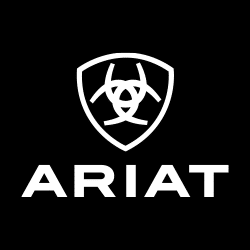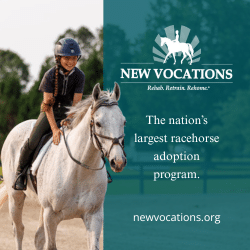
As many as 5–6% of Thoroughbreds develop a condition where the left arytenoid cartilage does not normally abduct (open), making them candidates for tieback surgery. Photo by Captivation Photography
The procedure known as “tieback surgery” is common in the world of Thoroughbred racing. In fact, Rolf M. Embertson, DVM, DACVS, a surgeon at Rood & Riddle Equine Hospital in Lexington, Kentucky, says as many as 5–6% of Thoroughbreds develop a condition where the left arytenoid cartilage does not normally abduct (open), making them candidates for tieback surgery.
The condition, recurrent laryngeal neuropathy, commonly referred to as “roaring,” can obstruct a horse’s airway during exercise, resulting in decreased performance and upper airway noise.
We wanted to learn more about tieback surgery, how it can impact an OTTB in his second career and what we can do if complications arise in the years after surgery, so we spoke to the experts.
What Is Tieback Surgery?
“Tieback surgery is a lay term used to describe the laryngoplasty surgery,” explains Santiago D. Gutierrez-Nibeyro, DVM, MS, clinical professor of equine surgery at the University of Illinois College of Veterinary Medicine, in Urbana. “This surgical procedure alleviates the clinical signs associated with recurrent laryngeal neuropathy in horses used for athletic activities such as racing.”
During tieback surgery the veterinarian uses sutures to abduct one of the arytenoid cartilages (again, typically the left side) to improve airflow in horses with a paralyzed or partially paralyzed arytenoid. The arytenoid cartilages have multiple functions in a horse’s larynx. Mainly they keep the airway open when needed and then come together to protect the top two-thirds of the trachea (or airway) when the horse swallows. The vocal folds, attached to the arytenoid, come together to protect the bottom one-third of the airway.
Much of the noise from a horse with a paralyzed arytenoid originates from the vocal fold(s) collapsing into the airway. “Since this obstructs airflow and creates sound, most horses also have at least one vocal fold removed with the tieback surgery,” explains Embertson. “I remove the left vocal fold in almost every left arytenoid tieback surgery I perform since this will often reduce noise significantly and also helps improve airflow. Some surgeons take out both. I don’t usually remove the right because when the horse swallows, the right arytenoid will adduct (close) beyond midline to meet the left arytenoid to help protect the top part of the airway.”
The same thing occurs with the vocal folds. “If you remove the left vocal fold, the right side comes across the midline to meet the remaining tissue to protect the lower part of the airway. So, if you remove the left and the right vocal folds you are at more risk of aspiration than if you just removed one side,” Embertson says. (Aspiration occurs when the horse inhales food into the windpipe which can cause inflammation, a lower airway infection or even pneumonia.)
On rare occasions, after a left tieback surgery, the horse’s right vocal fold collapses into the airway when back in training. Embertson explains this can be diagnosed during a dynamic upper airway exam — when the horse is scoped during strenuous exercise. In those cases, he will go back and remove the right vocal fold.
Although paralysis of either arytenoid can be caused by trauma to a recurrent laryngeal nerve, it is much more commonly a progressive disease affecting the left recurrent laryngeal nerve. “We sometimes see evidence of this condition in yearling Thoroughbreds, but there are many horses that look normal as yearlings and don’t develop the clinical manifestation of this disease until they are 2 or 3 years old,” says Embertson.
Why Is Tieback Surgery Performed on Racehorses?
During exercise in a healthy horse, the left and right cricoarytenoideus dorsalis (CAD) muscles contract and abduct the arytenoids up and out of the airway to increase airflow to the lungs. Embertson says there are times when the recurrent laryngeal nerve becomes nonfunctional, again, almost always on the left side. “This causes progressive paralysis of the CAD muscle and decreasing movement of the arytenoid. If the arytenoid does not abduct, it causes airflow obstruction during exercise, which adversely affects their performance.
“The tieback procedure helps about 60-70% of Thoroughbred racehorses return to near the level of competition they had achieved before developing arytenoid paralysis,” explains Embertson. “In the case of unraced horses, it can help them achieve a level near their potential before developing a problem. However, this depends on several factors, including the experience of the surgeon, if postop complications occur, and the innate ability of the horse.”
Embertson notes that if you look closely at an OTTB’s race record, you can sometimes see a shift in his performance when arytenoid paralysis becomes problematic. “As their condition progresses, the horse won’t be able to finish a race that’s more than five or six furlongs because the CAD muscle fatigues on the affected side, and the arytenoid gets sucked over the midline where it will obstruct airflow to about 40% of normal.”

Dr. Rolf Embertson performs laryngoplasty surgery, commonly known as tieback surgery, on a horse. “The tieback procedure helps about 60-70% of Thoroughbred racehorses return to near the level of competition they had achieved before developing arytenoid paralysis,” he says. Photo by Stephanie Welsh
Possible Short- and Long-term Complications of Tieback Surgery
Gutierrez-Nibeyro says that if an experienced surgeon performed the tieback surgery, the chances of having any postoperative issues are low. “But some of (the complications) can be pretty challenging to deal with, particularly chronic feed aspiration and cough.”
Failure of the tieback surgery or loss of abduction of the arytenoid ranks as the most common complication. “This occurs when the sutures through and around the laryngeal cartilages cut into the cartilage and/or settle into the adjacent soft tissues,” explains Embertson. “This loosens the sutures and allows the arytenoid to displace back towards the airway, where it will obstruct airflow. We have no control over how solid the cartilage is and, although you can somewhat tell how strong it is when you put the suture in, you don’t have that information going into the surgery. This is why tieback surgery is not 100% effective and why many horses develop complications.”
Can a Racehorse Have a Second Career After Tieback Surgery?
Both Embertson and Gutierrez-Nibeyro agree that if the tieback surgery was done well and there have been no postop complications, a horse can go into almost any second career. Embertson cautions that if the arytenoid has lost significant abduction, there will be some airflow obstruction, which can adversely affect horses in disciplines with strenuous exercise, such as eventing. “It seems like many OTTBs go into eventing as their second careers,” notes Embertson. “If you’re competing at a high enough level and you have a horse with a paralyzed arytenoid, he will need a tieback just to perform his job. If you’re competing at a lower level, he might be able to do his job without one. It’s very case by case.”
Notably, each horse is unique, and career restrictions can vary on a case-by-case basis. “I have seen several of these horses that had a tieback done in the past without complications and able to do just fine whatever athletic career they are involved in,” says Gutierrez-Nibeyro.
Complications After Tieback Surgery
Another less common complication that can develop is aspiration of water into the airway when eating and drinking. This causes the horse to cough and, if they cough excessively, it can lead to lower airway disease. “If this occurs, it is usually evident soon after surgery but can develop weeks or months later,” says Embertson. “If this becomes a significant problem, we can inject material that can bulk up the tissues into what’s left of the vocal fold on that side so that they don’t aspirate. Some people use bone cement, and I’ve used polyacrylamide gel on a couple that I’ve done. This can be a long-term fix for aspiration, but occasionally it is only a shorter fix that you will have to redo since it does not always work.
“Occasionally, we need to remove the tieback sutures and allow the arytenoid to drop back down towards the airway to protect it,” he continues. If the horse struggles with coughing, Embertson recommends wetting the hay and feeding the horse from the ground.
“If a horse had a tieback in the past and continues to have respiratory issues due to surgical failure, then there is a procedure called arytenoidectomy (removing the affected cartilage) that surgeons recommend,” says Gutierrez-Nibeyro. “However, this procedure can lead to long-term complications such as chronic feed aspiration and cough, and it can be costly.”
How To Handle the OTTB Prepurchase Airway Exam
Embertson and Gutierrez-Nibeyro both recommend having an upper airway endoscopy performed, also known as a “scoping” on any off-track Thoroughbred during the prepurchase exam. This is helpful for several reasons. For one, if you’re looking at an OTTB that has had a tieback surgery, it can help determine if the surgery was a success. For another, if the horse has clinical signs of an airway disease, a scope can determine if a paralyzed arytenoid could be to blame or if something else might be going on, such as arytenoid inflammation or an entrapped epiglottis. “It is worth the money to discover what might be going on,” says Embertson. “If the arytenoid looks like it is not very well abducted then you can almost count on that horse making some amount of upper airway noise. For some disciplines that doesn’t make a difference, but for others, like the hunters, it would.”
If you’re considering purchasing a horse that has had tieback surgery, Embertson recommends asking direct questions about the horse’s health history: “Has the horse had any complications post-surgery? Does he cough? Have you noticed any evidence of food residue or discoloration at his nostril?” Infrequently, it can take many months before a horse begins to aspirate after his tieback surgery. He mentions there’s no clear explanation for why that happens, but notes there are treatment options available if it occurs with your horse.
Take-Home Message
With many care and treatment options available for managing horses after tieback surgery, the procedure is less daunting for today’s owners. However, being aware of the potential long-term complications can help them make informed decisions when purchasing OTTBs—and planning out their second careers.
Corie Traylor is a full-time writer living in Portland, Oregon. She grew up riding horses on her family’s farm and currently owns two OTTBs, Bess and Mia.










